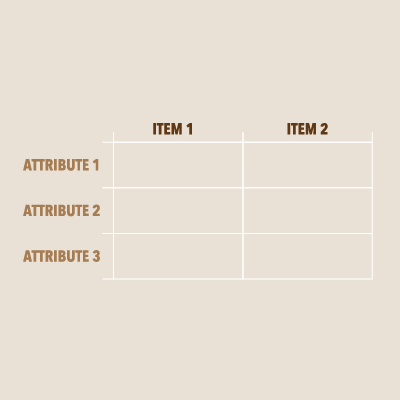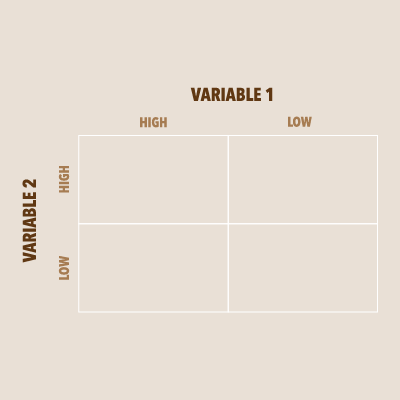Critical devices are used within frameworks to present information in a fresh perspective. They are sometimes referred to as “micro-frameworks”. The purpose of critical devices is to juxtapose the information to show contrast and create an epiphany. There are many critical devices that work well in presentations, here are four examples and when to use them.
Compare/Contrast Matrix
A matrix is a visual display of qualitative information. The power of a compare/contrast matrix is that you can compare two separate items (individuals, products, companies, etc.) across a series of attributes. In a presentation, a compare/contrast matrix is very effective in pointing out gaps between items.

2×2 Scale Matrix
A 2×2 matrix is a visual representation of a group of items across two distinct variables. For example, on the X-axis you could look at the value of a customer and compare that on the Y-axis to the expected effort to gain that customer. In a presentation, the 2×2 matrix creates four categories that can help businesses prioritize where they should focus their resources.

Small Multiples
A small multiple is a series of graphs that have the same scale or axes which allows for easier comparison. Small multiples often have time on one axis to show how different variables change over time. In a presentation, small multiples are most effective when the audience has times to process the changes in value on each graph. Be sure to dedicate enough time in the presentation so that the information is easily communicated.

Before and After Snapshots
Before and After Snapshots are a great way to show the visual impact of the work you have done on a project. By showing side by side what the state of the project was at the beginning and how it turned out at the end you can very easily point out to your audience how you improved. In a presentation, be sure to compare 1-to-1 examples of the content such as two screenshots of the website design, or two images of the collateral you improved.

Using a combination of critical devices throughout your presentation is sure to enhance the visual impact and ensure better digestion of the information presented. When information is displayed using a critical device, you allow the audience to have their own “epiphany moment” where they understand the context of the information better and have their own ideas for solutions.
About Weber Associates
Weber Associates is a Columbus, OH-based consulting firm. Since 1985, we have blended the creativity of a marketing agency with the analytical rigor of a consultancy to help our clients solve real sales and marketing challenges so they can significantly grow revenues and customer loyalty.



